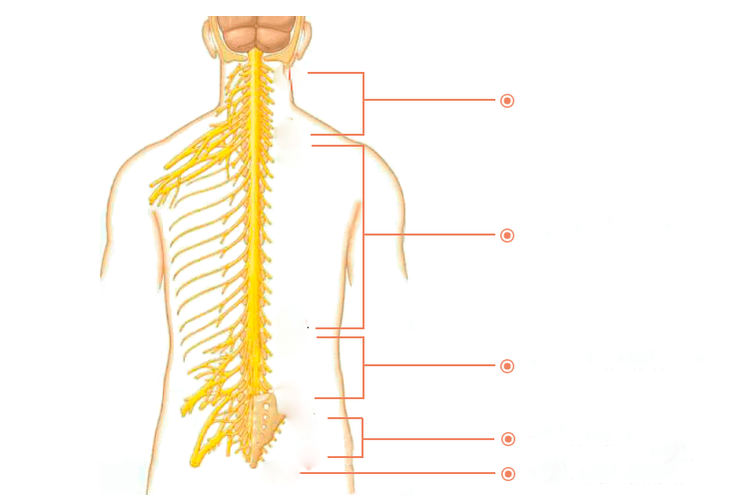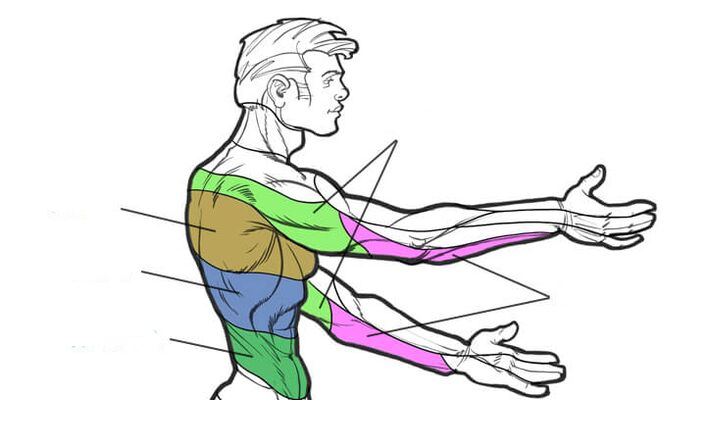The thoracic spine has one feature - the ribs join it. Therefore, it is less mobile than the neck and waist. As a result, osteochondrosis develops less often in the thoracic region, according to the principle: "less mobility - less wear". But it is less developed - it does not mean easier flow. And it really is. We are talking about chest pain. Because the pain zone of the thoracic spine coincides with the heart zone, symptoms are often confused with angina pectoris or myocardial infarction. Not surprisingly, thoracic osteochondrosis is called "chameleon". After all, it can manifest itself not only as a heart disease, but also as a disease of the lungs, liver, stomach, gallbladder or pancreas. And here you can not go wrong and ignore a heart attack or other serious disease, for example, pathology of the mammary glands in women. Although such mistakes are eventually corrected, they are costly. After all, it can "drag" a person to severe stress. Therefore, it is very important to find an experienced and knowledgeable doctor who will understand everything and distinguish the symptoms of thoracic osteochondrosis from other pathologies. Symptoms of thoracic osteochondrosis are usually divided into two categories - radical and reflex.
Radicular symptoms
They are formed as a result of the effect on the nerves coming out of the spine.
spinal nerves

There are many nerves coming out of the spine. They are called spinal nerves. Each of these nerves gradually branches off and follows a specific area of the body with clearly defined boundaries. This area is called the segmental innervation zone. Each vertebra, disc, nerve, and zone is numbered strictly according to each other. If a nerve is affected, symptoms appear in the segmental innervation zone corresponding to that nerve, and not just anywhere - in an arbitrary location.
Radical symptoms include:
- decrease or loss of reflexes;
- Sensitivity disorders;
- muscle weakness;
- The main pain.
Zones of innervation of thoracic segments
Osteochondrosis D1-D2- Causes pain in the shoulder, clavicle and armpit.

Osteochondrosis D3-D6- Pain in the upper part of the chest, causing the character of the belt. Pain in the heart mimics the onset of angina pectoris. Causes pain in the mammary glands in women.
Osteochondrosis D7-D8- Causes joint pain at the level of the solar plexus. Simulates pain in the stomach, liver, gallbladder or pancreas. Reduces upper abdominal reflexes
Osteochondrosis D9-D10- Causes pain in the hypochondrium and upper abdomen. Sometimes it mimics the so-called "acute" abdomen - a sharp pain in the abdomen. Reduces middle abdominal reflexes
Osteochondrosis D11-D12- Causes pain in the groin area. Simulates pain in gynecological diseases, appendicitis, intestinal diseases. Reduces lower abdominal reflexes
Reflex symptoms
Unlike radiculars, reflex symptoms have no clear boundaries. These may include: difficulty breathing, shortness of breath, pain during inhalation and exhalation, skin tremors and "gases", intercostal neuralgia, chest pain in the chest. Dyspepsia is often noted - loss of appetite, nausea, heartburn, bloating and fecal incontinence. Sleep is disturbed due to pain, insomnia and the feeling of not getting enough sleep. It is difficult to move, especially in the morning. The coordination of movements is disturbed - this is reflected in the gait. General weakness, weakness. Sexual dysfunction. Irritation. Rapid fatigue. There are different types of pain. Painful pain in the chest. Pain between shoulder blades. Pain in the hypochondrium. Pain when lifting arms. Pain when bending or trying to straighten. Pain between shoulder blades. In general, pain in osteochondrosis of the thoracic region can be divided into two types.
Dorsal- Prolonged pain in the back and chest area, moderately expressed with periods of intensification and weakening.
Dorsaqo- Acute pain in this area "lumbago".
- The symptoms of osteochondrosis of the thoracic region depend on the stage of osteochondrosis.
- They are aggravated by attempts to bend or straighten.
- Symptoms often appear after the age of 35-45.
- It occurs about 3 times more often in women than in men.
You have, of course, noticed that the radical symptoms are clearly defined and that the reflex symptoms are very vague and nonspecific. And as you know, anything without clear definitions serves as a cover for professional weakness. This applies, among other things, to reflex symptoms and a favorite concept among physicians, such as "age-related changes. "Many of you are no doubt familiar with the situation in which the doctor explains the problem by "reflex" or "age-related" processes. At such times, most people rightly believe that the doctor simply does not understand what is happening and tries to cover up his incompetence in the fog of these "magic words".
There was a famous saying: "Every accident has a name, surname, position. "Each disease has its own symptoms. The doctor's task is to know them clearly. And then you won't have to let go of the fog and blame osteochondrosis of the thoracic region for everything. You now understand how important it is to find an experienced and knowledgeable doctor. Both the correct diagnosis and good treatment results will depend on it.
Diagnosis is the key to proper treatment
To date, there are a number of modern methods of hardware diagnosis of osteochondrosis. The most accurate of these are MRI and CT. However, the main method is still clinical diagnosis - when an experienced doctor compares data from at least three sources - patient complaints, MRI results and symptoms detected during the examination. This allows you to make the most accurate diagnosis and create an effective individual treatment program.
Treatment
As you can see, osteochondrosis is a real "tangle" of symptoms that your doctor will save you from pain and suffering. However, changes in the vertebrae and discs cannot be eliminated. Therefore, the words "treatment of osteochondrosis" should be understood correctly. If you are interested in relieving pain and other suffering, yes - it is quite possible. If you have an academic discussion about restoring the spine and discs to their original appearance "like a newborn child, " no, the past cannot be undone. You need to be realistic, then you will not fall prey to scammers.
Do not fall prey to scammers!
It is impossible to restore the spine and discs to their original appearance!
What is the main treatment?
Mild manual therapy is the main type of treatment for osteochondrosis of the thoracic region. It's like an antibiotic for pneumonia - you can't do without it. Other types - massage, medication, physiotherapy and exercise therapy - are helpful.
How does gentle hand therapy work?
The nutrition of the discs is directly related to the muscles that surround the spine. In addition, the back muscles themselves are one of the main causes of pain in osteochondrosis of the thoracic region. Mild manual therapy is a special method that allows you to return the muscles to their natural physiology, eliminate spasms, muscle cramps and improve the nutrition of the discs.
The intervertebral discs are the only part of the body that has no blood vessels and is nourished by the proper functioning of the muscles.
In addition, when treating with the help of hands, chiropractic:
- remove the load from the affected vertebrae and discs and distribute it properly;
- relax the muscles and help them return to normal;
So:
- to save the patient from clamps;
- increase disk power;
- to restore the motor functions of the body;
- normalizes blood circulation.
Manual action mobilizes the body's internal forces and activates self-healing mechanisms.
The treatment is completely safe.
Prevention
Create a comfortable environment for yourself to sleep and work to prevent relapses. Pay attention to your weight and proper nutrition. Protect your physical activity. But the main thing is not to neglect your health and do not skimp on it. Don't let things go by themselves. After recovery, try to do at least one maintenance session of gentle hand therapy once every three to six months - this will reduce the risk factors. Remember, negligent osteochondrosis leads to complications - protrusion and disc herniation. Remember: your health, first of all, you need!
Escape from osteochondrosis leads to complications - protrusion and disc herniation.













































